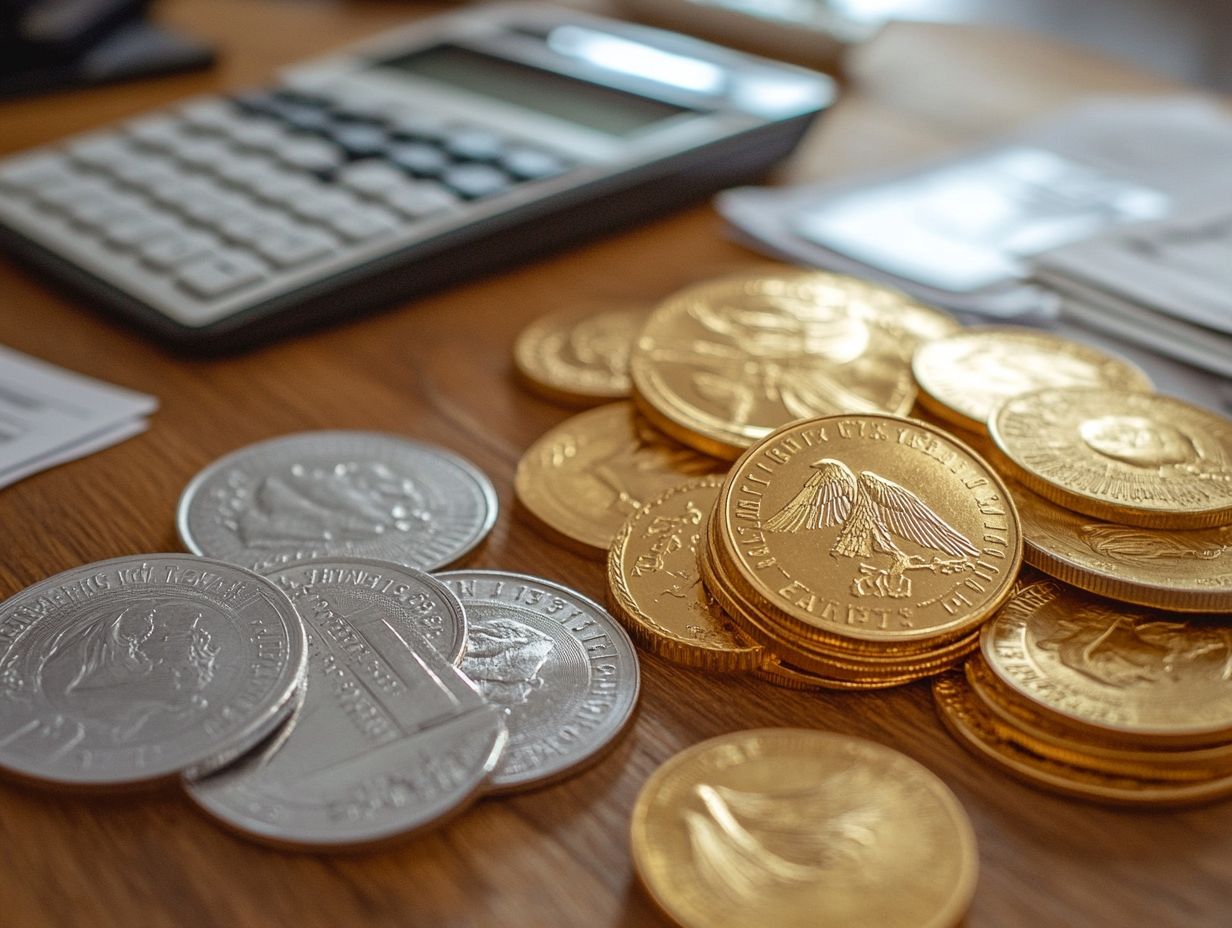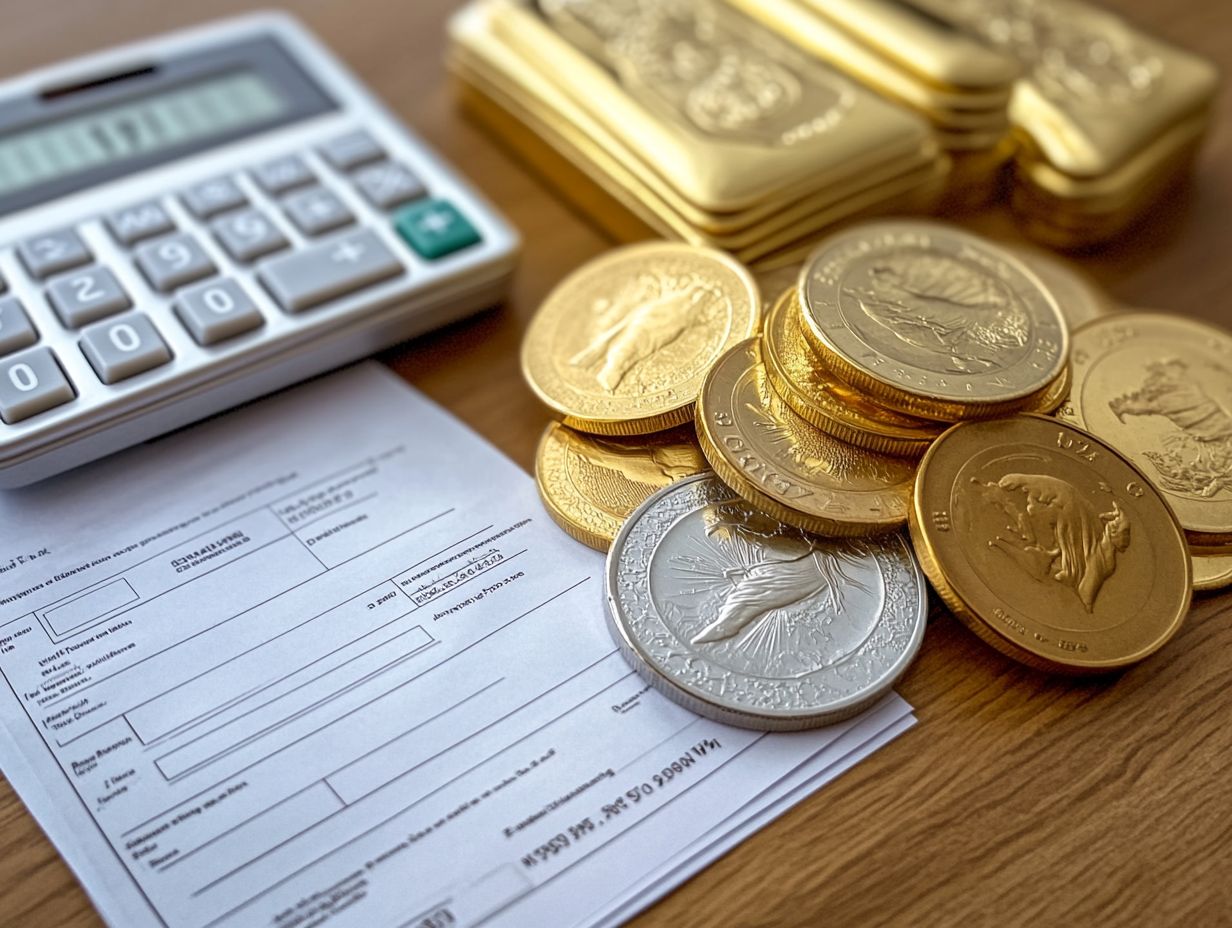How to Optimize Your Tax Strategy for Precious Metals
Investing in precious metals can be rewarding. However, it comes with tax implications you need to understand fully.
It’s crucial to know how capital gains and income taxes affect your investments. This knowledge is key to a solid financial strategy. This article delves into the various tax types associated with precious metals and presents effective strategies to minimize your tax burden.
You ll also find essential information on reporting and record-keeping requirements. This ensures that you are well-prepared as tax season approaches.
Join us in navigating the complexities of taxes in precious metals investing.
Contents
- Key Takeaways:
- Understanding the Tax Implications of Investing in Precious Metals
- Types of Taxes on Precious Metals
- Strategies for Minimizing Taxes on Precious Metals
- Reporting and Record-Keeping Requirements
- Frequently Asked Questions
- What is considered a precious metal for tax purposes?
- How can I optimize my tax strategy for precious metals?
- What are the tax implications of buying and selling precious metals?
- Can I deduct losses from selling precious metals on my taxes?
- Are there any tax advantages to donating precious metals?
- What are the tax implications of inheriting precious metals?
Key Takeaways:

- Understand the different taxes on precious metals, such as capital gains and income tax.
- Use strategies like holding investments longer and offsetting gains with losses to reduce your tax burden.
- Keep up with reporting and record-keeping to comply with IRS requirements.
Understanding the Tax Implications of Investing in Precious Metals
Investing in precious metals like gold and silver has distinct tax implications that require careful navigation in the United States. Understanding these ramifications is vital for effective tax planning and maximizing your benefits, especially regarding capital gains and investment taxes.
Consulting a tax professional can clarify the nuanced reporting obligations and IRS requirements related to these asset classes. This ensures compliance while optimizing your portfolio.
Since precious metals often act as a hedge against market volatility, comprehending how these factors interact in the broader investment landscape is crucial.
Types of Taxes on Precious Metals
When you invest in precious metals, various taxes can come into play, including capital gains tax, income tax, and the alternative minimum tax. Each tax requires careful consideration.
Understanding these tax implications is essential for compliance and effective tax planning, as they can significantly influence your overall investment returns and portfolio diversification.
Capital gains tax applies when you sell your precious metals at a profit. Income tax may impact any dividends or interest earned from investments in tax-advantaged accounts like IRAs or 401(k)s. The alternative minimum tax can add complexity for high-income investors. Consulting a tax professional can help you navigate these intricacies.
Capital Gains Tax
Capital gains tax is crucial for you to consider as an investor in precious metals. It applies to profits from selling assets like gold and silver. This tax varies depending on how long you hold your investments, distinguishing between long-term gains and short-term rates.
If you hold an asset for more than a year, long-term capital gains typically benefit from lower tax rates. This highlights the importance of strategically planning your buying and selling to minimize tax liabilities. A tax professional can provide personalized insights into these complex regulations.
Recognize that short-term capital gains, arising from the sale of assets held for a year or less, are taxed at higher ordinary income rates. This can significantly reduce your overall profits. For instance, selling gold bullion shortly after purchasing could diminish your earnings. Holding onto the asset for a longer period may be more advantageous.
Consider structuring your investments through tax-advantaged accounts or employing strategies like tax-loss harvesting to enhance your net returns. Seeking guidance from a qualified tax advisor isn t just advisable; it s essential for making informed decisions that align with your broader financial goals.
Income Tax
Understanding income tax on precious metals is crucial for every investor. Investors in precious metals often face income tax implications, especially when it comes to dividends from investments in various legal entities like trusts and LLCs.
In the realm of precious metals, income tax can emerge from interest payments on investment products or distributions from tax-advantaged accounts. Understanding these income tax requirements is essential for effective tax planning, enabling you to maximize your tax advantages while mitigating potential liabilities.
Seek guidance from a tax professional for navigating the complexities of income tax related to precious metals investments.
The importance of utilizing tax-advantaged accounts such as IRAs or 401(k)s cannot be overstated; these vehicles provide potential tax deferral benefits that can significantly enhance your overall investment returns. For example, by holding precious metals within these accounts, you might reduce your immediate tax burdens while still reaping the rewards of price appreciation. To fully understand the implications, it’s crucial to learn about understanding your tax obligations for precious metals.
Depending on the specific account structure, dividends or interest payments generated within these accounts may not be subject to immediate taxation. This shows why you need a thorough review of your portfolio alongside a knowledgeable advisor who can offer strategic insights.
Tax professionals can assist you in crafting a plan that maximizes your returns while minimizing AMT impacts, enabling you to make well-informed decisions about when to buy or sell. Don’t miss out on tax savings! Being proactive in understanding these factors is key to your financial success.
Alternative Minimum Tax

The alternative minimum tax (AMT) can pose distinct challenges for you as an investor in precious metals. This tax system, crafted to ensure that high-income earners contribute a minimum amount, makes investing more complicated for those holding assets like gold and silver.
Grasping the implications of AMT is essential, as it can influence your deductions and the overall taxation of your investments. If you have significant holdings in precious metals, it’s prudent to consult a tax professional to evaluate your exposure to tax regulations around precious metals in 2024 and develop a tailored strategy.
The potential liabilities become even more intricate when considering how AMT interacts with standard tax obligations, creating a maze of regulations that can feel overwhelming. For example, gains from selling your precious metals might not be treated favorably under AMT, leading to higher tax rates compared to other types of investments.
This reality underscores the importance of a comprehensive review of your portfolio. Tax professionals can assist you in crafting a plan that maximizes your returns while minimizing AMT impacts, enabling you to make well-informed decisions about when to buy or sell.
Strategies for Minimizing Taxes on Precious Metals
Minimizing taxes on your precious metals investments demands strategic planning and a keen understanding of diverse tax strategies, including tax loss harvesting and leveraging tax-advantaged accounts.
Tax loss harvesting means selling investments at a loss to reduce your tax bill. By effectively applying these techniques, you can significantly enhance your overall returns while staying in line with IRS reporting requirements.
Tax-advantaged accounts like an IRA or 401(k) serve as excellent vehicles for tax-deferred growth. By exploring these options, you can achieve better portfolio diversification and asset protection, all while navigating the intricate landscape of tax obligations.
Holding Period and Tax Rates
The holding period of your investments in precious metals plays a significant role in determining the tax rates that will apply when you decide to sell. This factor is crucial for effective tax planning.
When you hold your assets for more than a year, you unlock the potential for preferential long-term capital gains tax rates. These rates are usually more favorable than the short-term rates that kick in for sales made within a year.
This difference in tax treatment can lead to meaningful savings, especially if you’re strategically planning your investments. By thoughtfully considering how long to hold your precious metals before selling, you can optimize your tax outcomes and enhance your overall investment strategy.
Integrating this understanding into your financial planning is essential for maximizing returns and achieving your financial objectives.
Offsetting Gains with Losses
Tax loss harvesting, which means selling investments that have lost value to reduce your tax on gains, is a powerful strategy that can help you offset gains from the sale of precious metals. This allows you to minimize your overall tax liabilities.
By strategically selling underperforming assets to generate losses, you can offset capital gains and potentially reduce your taxable income. You need careful planning and a good grasp of IRS regulations to ensure compliance and optimize your tax advantages.
Leveraging tax loss harvesting enhances your overall investment returns and supports a well-balanced portfolio diversification strategy.
Timing is everything in this method! It involves precise timing and a keen awareness of market conditions to effectively maximize your benefits. For example, if one part of your portfolio, like precious metals, appreciates sharply while another segment lags behind, converting those losses into tax benefits becomes a savvy move. This allows you to stay aligned with your long-term investment goals without slipping into higher tax brackets.
It encourages a disciplined approach to investing. You should continuously evaluate your performance against broader market trends, ultimately fostering a resilient financial strategy that aligns perfectly with your personal financial objectives.
Utilizing Tax-Advantaged Accounts
Utilizing tax-advantaged accounts like IRAs and 401(k)s can unlock substantial benefits for you as an investor in precious metals. These accounts provide opportunities for tax-deferred growth and enhanced portfolio protection. They not only allow you to include precious metals such as gold and silver but also enable you to enjoy various tax benefits, including the potential to reduce your taxable income.
Grasping the rules and regulations governing these accounts is essential for maximizing your investment s tax benefits and ensuring compliance with IRS reporting requirements.
By leveraging these accounts, you can skillfully navigate the complexities of capital gains taxes, preserving more of your earnings over the long haul. For more insights, check out how to simplify your tax process for precious metals. Tax-advantaged accounts can alleviate the immediate financial burdens of income tax, allowing your precious metal investments to appreciate without the drag of annual taxation.
It’s crucial to follow the liquidity and distribution guidelines established by the IRS, as any missteps could lead to penalties or unexpected tax liabilities. Therefore, familiarizing yourself with the specific types of metals allowed and the associated custodial fees can significantly enhance your overall investment strategies. Additionally, exploring tax strategies for maximizing returns in precious metals can provide valuable insights.
Reporting and Record-Keeping Requirements

As an investor in precious metals, it s vital for you to understand the specific reporting and record-keeping requirements that keep you in line with IRS regulations.
This often means tackling various forms, such as Form 1099-B to report your sales of precious metals, Form 8949 to summarize your capital gains and losses, and Form 8300 for any cash transactions.
Grasping these reporting requirements is key to sidestepping potential penalties and ensuring your tax filings are accurate. Diligent record-keeping of all transactions, purchases, and sales is essential for substantiating your claims and effectively meeting your IRS reporting obligations.
What Information to Report to the IRS
When you report to the IRS, it’s essential to provide specific information about your transactions in precious metals. This includes details required on forms like Form 1099-B and capital gains summary. Accurate reporting is not just a good idea; it s crucial for following the rules. Get it right to enjoy a smoother tax season!
You should document each sale meticulously, noting the date of the transaction, the proceeds, and the original purchase price. These details are vital for calculating capital gains, which are the profits you make when you sell your investments for more than you paid, and fulfilling your reporting obligations.
Stay aware of any state or local taxes that may apply to the profits from your precious metal dealings. Keeping precise records of your purchases, sales, and associated costs will help you substantiate claims in the event of an audit. For more information, check out our guide on how to track your precious metals for tax purposes.
Forms like Form 1099-B not only streamline the reporting process but also serve as official documentation that the IRS recognizes as verification of income from these sales. By paying careful attention to these guidelines, you can navigate the complexities of tax reporting with greater ease, contributing to a smoother operational process and enhanced peace of mind.
Keeping Accurate Records for Tax Purposes
Accurate record-keeping is essential for you as an investor in precious metals. It underpins your compliance with IRS reporting obligations and ensures your tax returns accurately reflect your financial activities.
This practice goes beyond merely tracking your initial purchases and sales. It requires you to document all associated expenses, such as storage fees and insurance, which can significantly impact your taxable gains. You should keep receipts and any correspondence related to your investments, as these documents could prove invaluable during tax season or in case of a dispute.
By regularly updating your records and utilizing investment management software tools, you not only align with vital compliance standards but also gain insights that can refine your future investment strategies. This can potentially reduce your tax liabilities.
Frequently Asked Questions
What is considered a precious metal for tax purposes?
Precious metals for tax purposes typically include gold, silver, platinum, and palladium in the form of coins, bars, or bullion.
How can I optimize my tax strategy for precious metals?

One way to optimize your tax strategy for precious metals is to hold them in a tax-advantaged account such as a self-directed IRA or a precious metals IRA.
What are the tax implications of buying and selling precious metals?
The tax implications of buying and selling precious metals depend on the type of account in which they are held. If held in a taxable account, gains are taxed as capital gains. If held in a tax-advantaged account, such as a precious metals IRA, gains are tax-deferred.
Can I deduct losses from selling precious metals on my taxes?
Yes, losses from selling precious metals can be deducted on your taxes. However, these losses can only be deducted from gains in the same type of account (taxable or tax-advantaged).
Are there any tax advantages to donating precious metals?
Yes, donating precious metals can provide tax advantages. If the donation is made to a qualified charitable organization, you may be able to deduct the fair market value of the metals on your tax return.
What are the tax implications of inheriting precious metals?
The tax implications of inheriting precious metals depend on the value of the metals at the time of inheritance. If the value has increased since the original purchase, the beneficiary may owe capital gains taxes on the appreciation. If the value has decreased, the beneficiary may be able to claim a tax loss.















